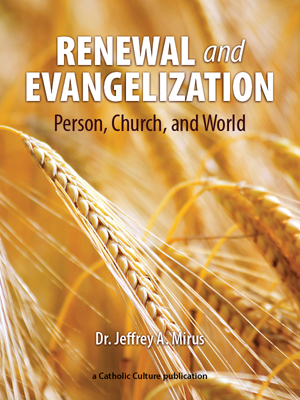Laying the Foundation: The Little Oratory
By Jennifer Gregory Miller ( bio - articles - email ) | May 09, 2014 | In The Liturgical Year
The family is the root of society, and a miniature reflection of the Mystical Body, the family of God. We can all agree there is a crumbling of the traditional family. Oftentimes the family is isolated, no longer having the support system of grandparents, aunts and uncles and cousins or even ethnic or Catholic communities. Many in the 60s and 70s eschewed tradition, including of all the parental advice and experience of raising a family, leaving so many of those in the next generation trying to figure things on our own. We have lost our roots, our connections, our culture and our heritage. (No wonder there is a proliferation of self-help books; we have become quite an insecure lot.) Alongside this absence of parental advice is the lack of direction in growing in the Faith within the family, the domestic church.
My parents did try to preserve and live the Faith in our family, but knew they couldn't do it alone. Besides the support of her family, my mother owned several books she referred to for guidance and inspiration along the way. When I left home to start my own family, I tried to find many of the Catholic books that helped guide her in living the life of the Church within the family. In my search for finding some of those titles, I found other books to add to my library. Of all the bookshelves in my home, this is the shelf I refer to most often. I continue to hunt down these Catholic books to give as gifts. These books stem from the Liturgical Movement by authors such as Mary Reed Newland, Maria von Trapp, Mary Perkins Ryan and Florence Berger. Some are out-of-print, and others are reprinted. I'm also always on the look-out for new books that can stand alongside these classics to share them as gifts to siblings and friends, especially those who are beginning their families.
David Clayton and Leila Lawler (wife of Phil Lawler of Catholic World News) have recently written The Little Oratory: A Beginner's Guide to Praying in the Home. It is published by Sophia Institute Press and contains beautiful color and line drawings of icons by David Clayton and illustrations by Deirdre Folley. This book fits right alongside with these other classic titles. Actually it should take primacy, because it lays the foundation of prayer life within the home.
The use of the word "Oratory" is not common, although it's referred to in the Catechism, so the title might be a bit confusing. Generally the term refers to a little private chapel, usually for home use. Clayton and Lawler widen the definition as "a little sacred space." How this space looks varies from home to home, whether it be an icon corner, a prayer table, a home altar, or part of the dining table, but the goal is to have small area in the home put aside for God. Decorated with simple beauty it should be a visual reminder for us to turn our hearts to God throughout the day. It is also a place where family members can come to pray, either individually or as a family.
The book provides suggestions and practical advice on how to set up an oratory and how to pray, particularly united to the Church through the liturgy. The ideas for the prayer table or icon corner are not intended to be strict rules like the building of the Ark of the Covenant but simple inspiration. Everyone's home and taste and prayer life varies, but there are basic principles of beauty, simplicity, order, symmetry, etc. that should be followed. The extra-special part of this book is that the reader will not have to search high and low for perfect images for the home altar. The book includes beautiful color icons painted (or written...the difference is explained in the book) by David Clayton that are ready to be used. There are also line drawings of icons that can be reproduced and painted.
Note the title does not include the word family, but "home". The book is not only directed towards families with two parents, but there is practical advice aimed at single parents and singles. There is also guidance on praying in the office and the parish. In short, the book has universal application. The book title uses the word "beginners" but we are beginners in some way in our paths of prayer and we all are called to set aside prayer in our hearts, time in our day, and a little sacred space for God.
Being both converts, the authors had difficulty wading through all the Catholic devotions and practices and traditions. Where to begin? Which are priority? How to avoid being overwhelmed? They realized a book like this that starts from the beginning and lays the foundation for prayer life in the home was needed.
Even as a cradle Catholic I can see how difficult it is to wade through all the different devotions. One day a dear friend sighed to me that she had "only" gone to Mass on a feast day and didn't "celebrate" the feast. I responded that she "celebrated" in the highest way -- with the Liturgy of the Church. The Church provides guidance and emphasizes that the Liturgy should take primacy over all private devotions, but that is either not realized or often forgotten. The Internet and social media are full of different expressions of "living" the Faith, especially through crafts and foods for the Liturgical Year, but these can only be done authentically when there is a foundation of a family prayer life. This book is a perfect guide to help sift through all the extras and recognize how we must establish a unity with the Universal Church and put Liturgy as priority before we add the extra trimmings of private devotions.
Part of the Church's official worship includes the Liturgy of the Hours or Divine Office, and this is one form of liturgy that can translate into the home for family prayer (and the authors elaborate how this prayer can become ecumenical, also). Participation in the Liturgy, such as the Mass and Divine Office, is the highest form of prayer because it unites us with the Universal Church, the Mystical Body, our community of Faith. The authors share sound advice and practical suggestions on implementing the Liturgy of the Hours in the home. They do not expect it to be obligatory as it is for priests and religious, nor do think it realistic to pray all parts of the hours of the day. Their recommendations of different (and sometimes small) ways of praying the different hours is priceless. And as we build our family through this prayer, we are also building up the Church community. Our prayer can slowly transform the world.
Each chapter stands alone, so it is a book that can be read in snatches at any time. After I read through it once, I'm already referring back to favorite sections. I found myself nodding in agreement throughout the book, seeing areas where I could improve in my home, and discovering new ideas and approaches that I want to implement. This is not just about building a prayer table and praying the Divine Office, but understanding the role of family within the life of the church, the role of beauty, of symmetry, of simplicity and of prayer. After setting aside the space and establishing a prayer life, preferably united through the liturgy, the authors touch on other areas of prayer and devotion, such as the Liturgical Year, the rosary, Morning and Night prayers, prayer throughout the day, dedications of the days and months, and simple recognition of feast days and family days.
I really enjoyed the second chapter on the Family and the Home, but my favorite is Chapter 9: "Who Prays and Who Leads Prayer in the Little Oratory?" which touches on the complementary roles of men and women, and how they translate in the home. The wife and mother is the heart of the home, but it the husband and father who is the leader. It is important that, if possible, the father should be the leader of the prayers. This does not mean just saying the beginning of the "Our Father" but the calling to prayer in general. This is rarely stated, but i have found it definitely true and it can reap much fruit in following this principle.
The emphasis of this book is finding that union with God in the home mainly through the liturgy, recognizing the role of simplicity and beauty. The authors reiterate that "[t]he most important part, which we hope we've conveyed, is the ordering principle--not any particular quantity of observance--that allows you to select the beautiful pattern of prayer that is perfect for you and your family, offered by Christ Himself." The suggestions are simple, uncomplicated, but very practical. We all have different seasons of life and every family is different, but the authors make great suggestions that can fit all lives, even single and single parents. I think this book needs to be read by every Catholic, and should be one of the first books read before embarking in the Sacrament of Matrimony.
All comments are moderated. To lighten our editing burden, only current donors are allowed to Sound Off. If you are a current donor, log in to see the comment form; otherwise please support our work, and Sound Off!
-
Posted by: Litlflwr2800 -
May. 10, 2014 3:48 PM ET USA
This sounds like just the book I've been seeking for years. I'm so intrigued, I went ahead and ordered a copy just now! After reading through the sample on Kindle, I have to agree with the author of this post; this book will be an important resource in our home.








